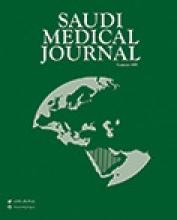Abstract
OBJECTIVE: To evaluate the prevalence and pattern of antituberculous drug resistance and patients with pulmonary tuberculosis in the Eastern Province and its impact on the tuberculosis control program.
METHODS: Patients with pulmonary tuberculosis, proven by culture, admitted to Dammam Chest Hospital from November 1993 through May 1996 were reviewed. Patients who had at least one documented isolate of mycobacterium tuberculosis resistant to at least one standard anti-tuberculosis drug were identified. Medical records were reviewed and information was retrieved regarding age, sex, nationality, history of previous tuberculosis, human immune deficiency status, and results of direct smear and chest radiograph abnormalities.
RESULTS: A total of 411 cases of culture positive pulmonary tuberculosis with drug susceptibility testing, were identified during the period mentioned, of these 123 (30%) were Saudi nationals and 228 (70%) were non-Saudis. Drug resistance to at least one drug was observed in 43 (10.5%) patients, resistance to isoniazid alone was observed in 25 (6%) patients, whereas resistance to rifampicin was noted in only one (0.2%) patient, and to streptomycin in 3 (1%) patients, multidrug resistance was observed in 11 (3%) patients.
CONCLUSION: The study has shown that the overall drug resistance rate of 10.5% in the Eastern Province of Saudi Arabia is the lowest reported in the Kingdom, compared with Riyadh (13%), Taif (23%) and Gizan (44%). However, it appears to be similar to that reported in neighboring countries. In light of the study findings, and as per the recommendation of the World Health Organization, we suggest that a 4-drug regimen, as an initial treatment for pulmonary tuberculosis should be maintained, as resistance to isoniazid is still higher than the cut off value of 4%, and susceptibility testing for first line antituberculosis drugs should be carried out whenever possible. We also recommend applying stricter medical criteria for tuberculosis screening in newcomers, and for Saudi nationals, application of directly observed therapy should be a priority.
- Copyright: © Saudi Medical Journal
This is an open-access article distributed under the terms of the Creative Commons Attribution-Noncommercial-Share Alike 3.0 Unported, which permits unrestricted use, distribution, and reproduction in any medium, provided the original work is properly cited.






